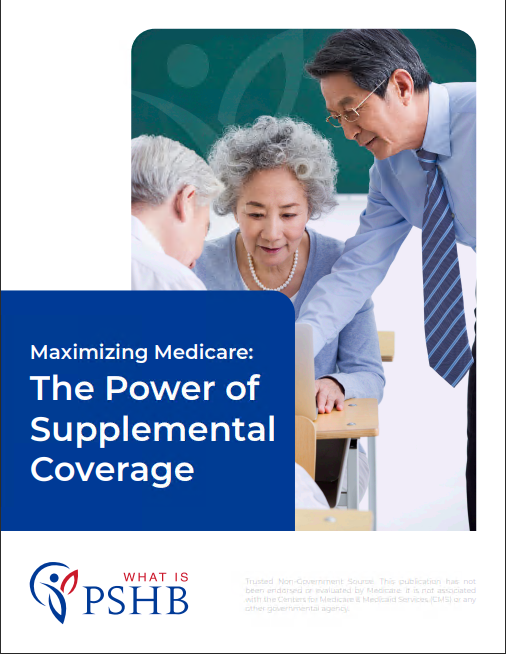Key Takeaways
-
While Medicare Part A does not require a monthly premium for most people, you can still face substantial out-of-pocket costs during hospital stays if you don’t coordinate it properly with PSHB.
-
PSHB plans can help reduce or eliminate many of the hospital-related expenses that Medicare Part A does not fully cover—but only if you understand how the coordination of benefits works.
What Medicare Part A Covers—and What It Doesn’t
Medicare Part A, also known as hospital insurance, helps pay for inpatient care in hospitals, skilled nursing facilities, hospice, and some home health services. If you or your spouse paid Medicare taxes for at least 40 quarters, you qualify for premium-free Part A. But that doesn’t mean your hospital care is entirely covered.
In 2025, Medicare Part A comes with these costs:
-
$1,676 deductible for each benefit period
-
Daily coinsurance after 60 days of hospitalization: $419 per day for days 61–90, and $838 per day for days 91–150 (lifetime reserve days)
-
Skilled nursing facility coinsurance: $209.50 per day for days 21–100
This can add up quickly. A prolonged hospital stay or a skilled nursing admission without backup coverage may leave you with a large bill.
The Role PSHB Plays in Supplementing Part A
If you’re eligible for Postal Service Health Benefits (PSHB) and also enrolled in Medicare, the two can work together to limit your out-of-pocket expenses. PSHB plans are required to coordinate benefits with Medicare, and many provide significant financial protections.
Here’s how PSHB typically helps fill the gaps:
-
Covers or reduces your Part A deductible
-
Covers hospital coinsurance amounts beyond the Medicare limits
-
Covers skilled nursing care costs that exceed Medicare’s time limits
However, the specifics vary by plan. While most PSHB plans reduce or eliminate inpatient costs for enrollees with Medicare, the level of cost-sharing depends on your exact PSHB plan and how it coordinates with Medicare.
Medicare Is Usually the Primary Payer
In almost all cases, Medicare pays first once you’re enrolled in both Medicare and PSHB and are retired. PSHB becomes the secondary payer, which means:
-
Medicare pays its share of covered hospital services
-
PSHB picks up most or all of the remaining cost, depending on plan details
If you’re still an active USPS employee and have PSHB, then PSHB will pay first and Medicare will pay second. But once you’re retired, this switches—and that matters greatly when figuring out how much you’ll owe after a hospital stay.
Don’t Ignore the Benefit Period Rules
Medicare’s benefit period resets after you’ve been out of a hospital or skilled nursing facility for at least 60 days. That means you could pay the $1,676 deductible multiple times in one year if you have more than one hospital stay.
PSHB plans that coordinate with Medicare often waive or cover subsequent deductibles, but this isn’t guaranteed. You need to review your plan materials or speak with a licensed agent listed on this website to be sure.
Emergency Room Visits and Observation Status
One of the most confusing areas of Medicare Part A is the difference between inpatient admission and observation status. Observation stays—even if they last overnight—are considered outpatient care under Medicare Part B, not Part A. This distinction affects how costs are covered.
Here’s how it breaks down:
-
If you’re formally admitted as an inpatient, Medicare Part A covers the hospital stay
-
If you’re kept under observation, Medicare Part B applies, and you may have higher out-of-pocket costs depending on your PSHB plan
PSHB plans usually provide some form of coverage for observation services, but because these are billed under Part B, the financial protections differ.
Skilled Nursing Facility Care Has Its Limits
Medicare Part A covers skilled nursing facility care only if all the following apply:
-
You have a qualifying 3-day inpatient hospital stay (not counting observation)
-
You enter the SNF within 30 days of discharge
-
You need skilled care daily that can only be provided in a SNF
If eligible, Medicare covers the first 20 days in full. From days 21–100, you pay a daily coinsurance of $209.50 in 2025. Beyond 100 days, you pay all costs.
Your PSHB plan may help:
-
Extend coverage beyond 100 days (though not always)
-
Reduce or eliminate the $209.50 daily coinsurance for days 21–100
But if you don’t meet Medicare’s eligibility criteria, Part A won’t pay at all—and you’ll be entirely dependent on your PSHB plan.
Don’t Rely on Lifetime Reserve Days Too Heavily
You get 60 lifetime reserve days with Medicare Part A. These are extra hospital days Medicare covers once you exceed 90 days in a single benefit period. In 2025, each of these days comes with a $838 coinsurance charge.
Once you’ve used up all 60 of these lifetime reserve days, Medicare stops covering those extra days entirely. You’ll either need to rely on your PSHB plan or pay the full cost yourself.
Not all PSHB plans will cover unlimited hospital days beyond what Medicare allows, so it’s essential to review the limits built into your plan.
Medicare Enrollment Timing Affects PSHB Coordination
The timing of your Medicare enrollment can have a big impact on how smoothly your PSHB plan covers you. If you’re a Postal Service annuitant and Medicare-eligible in 2025, you are likely required to enroll in Medicare Part B to maintain full PSHB benefits.
Failure to enroll in Part B (and Part A, if you’re not automatically eligible) could result in:
-
Loss of secondary coverage from PSHB for hospital services
-
Higher out-of-pocket costs for both inpatient and outpatient care
Make sure to enroll during your Initial Enrollment Period, which begins three months before you turn 65, includes your birthday month, and ends three months afterward. If you miss that window, you may have to wait until the General Enrollment Period (January 1 to March 31) and face late penalties.
What Happens Without Medicare
If you’re eligible for Medicare and choose not to enroll—especially in Part B—your PSHB plan may shift to being your primary payer, but with significantly reduced cost-sharing protections. Some plans:
-
May not cover hospital deductibles or coinsurance at all
-
May reduce coverage amounts for inpatient services
-
May exclude some benefits entirely unless you’re enrolled in both Part A and Part B
If you delay Medicare enrollment and rely on PSHB alone, you risk facing higher out-of-pocket costs in a hospital stay.
How PSHB Prescription Drug Coverage Works with Part A
Medicare Part A does not cover most prescription drugs. It only pays for drugs during inpatient hospital stays or limited skilled nursing stays.
PSHB plans typically include a comprehensive prescription drug benefit, and for Medicare-eligible enrollees, this is often integrated through a Medicare Part D Employer Group Waiver Plan (EGWP). With this setup:
-
You gain access to the Medicare Part D $2,000 out-of-pocket maximum
-
Your drug costs may be lower even during hospitalization
-
Some plans offer $35 caps on select medications like insulin
But to access these benefits, you must remain enrolled in both Medicare and PSHB.
Getting Clarity on Your Coverage Before You Need It
The worst time to figure out how Medicare Part A and PSHB interact is after you’ve been hospitalized. The rules are detailed and the costs can escalate quickly.
To avoid unpleasant surprises:
-
Review your PSHB plan’s coordination of benefits with Medicare
-
Understand what costs are covered under Part A and which aren’t
-
Talk to a licensed agent listed on this website for a personalized breakdown
Preparing for Hospital Costs Before They Happen
Hospital care may be necessary, but it shouldn’t become a financial crisis. By understanding the relationship between Medicare Part A and your PSHB coverage, you can take steps now to ensure you won’t be hit with large bills later.
Review your PSHB plan, stay current on your Medicare enrollment, and verify that your benefits are working in your favor—not against you. For guidance tailored to your specific situation, reach out to a licensed agent on this website.






